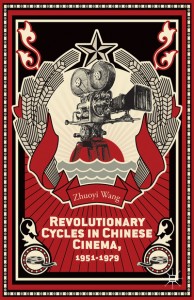Revolutionary Cycles in Chinese Cinema, 1951-1979 by Zhuoyi Wang (Palgrave Macmillan, 2014), 278 pages ISBN: 978-1137378736 (hardback) £60
 About the reviewer: Professor Chris Berry teaches in Film Studies at King’s College London. Previously Professor of Film & Television Studies at Goldsmiths, University of London (2004-2012); Associate Professor in Film Studies at the University of California, Berkeley (2000-2004); Lecturer at La Trobe (1990-2000) and Griffith (1988-1989) universities in Australia; and consultant at the China Foreign Languages Press (1987-1988) and China Film Corporation in Beijing (1985-1987). He edited the four-volume Routledge Major Works text, Chinese Cinema, in 2012; his other publications include Public Space, Media Space (2013), co-ed with Harbord, J. & Moore, R. (Palgrave Macmillan);
About the reviewer: Professor Chris Berry teaches in Film Studies at King’s College London. Previously Professor of Film & Television Studies at Goldsmiths, University of London (2004-2012); Associate Professor in Film Studies at the University of California, Berkeley (2000-2004); Lecturer at La Trobe (1990-2000) and Griffith (1988-1989) universities in Australia; and consultant at the China Foreign Languages Press (1987-1988) and China Film Corporation in Beijing (1985-1987). He edited the four-volume Routledge Major Works text, Chinese Cinema, in 2012; his other publications include Public Space, Media Space (2013), co-ed with Harbord, J. & Moore, R. (Palgrave Macmillan);
This concise and incisive book makes an important intervention into the study of Chinese film history. It deserves a readership beyond those with a special interest in Chinese cinema, because Wang argues for what I would consider a cultural rather than either text or production-based approach to film history in general. In other words, rather than focusing on the films alone or the policies and production practices that shape them, Wang draws on Rick Altman’s insights about film genres to emphasize what she calls a ‘user-centred’ approach. She examines how different social and political groups use films for their own purposes, and how this shapes both their production and reception. The result is not only a livelier and more engaging picture of Chinese revolutionary era film history but also a model for conducting this new kind of film history.
 Wang challenges existing work on the cinema of the revolutionary era in the People’s Republic of China on two counts. First, as she notes, Yomi Braester and Tina Mai Chen co-edited a special issue of the Journal of Chinese Cinemas (5, no.1) in 2011 on this period, which they billed as ‘the missing years’ in Chinese film studies scholarship. Wang’s book makes an important contribution to filling the gap.
Wang challenges existing work on the cinema of the revolutionary era in the People’s Republic of China on two counts. First, as she notes, Yomi Braester and Tina Mai Chen co-edited a special issue of the Journal of Chinese Cinemas (5, no.1) in 2011 on this period, which they billed as ‘the missing years’ in Chinese film studies scholarship. Wang’s book makes an important contribution to filling the gap.
Second, she argues that the existing scholarship paints too monolithic a picture of party control that makes the films and their cultural lives less complex and interesting than they are. Wang uses the incessant cycles of revolutionary activity that animated the People’s Republic prior to Deng Xiaoping’s ascent to power in the late 1970s to argue this was not a monolithic and homogenous era at all. Furthermore, not only were there numerous different factions who attempted to use films for their own interests of various kinds. Also, there is evidence now from published and unpublished records that audience responses to films, even in the most draconian periods, were unpredictable and driven by their own interests.
Wang proposes a new periodization for the revolutionary era. Instead of a simple break into two periods marked by the start of the Cultural Revolution, she structures her book around the nationalization of the film industry in the early 1950s, the Hundred Flowers period of relative openness and the backlash against it in the late 1950s, then what she calls the ‘Second Hundred Flowers’ in the early 1960s, and finally the Cultural Revolution and its aftermath. In each case, she is able to locate key films, less on the basis of their aesthetic representativeness and more on their role in these cycles. Hitherto dismissed works become more interesting. For example, Song Jingshi (1957) comes to life for readers because of the numerous revisions it went through during its costly and long process of production, followed by critical debates, making it a key site for political and aesthetic struggles over cinema form and content. Other films that have already received much critical attention, such as Early Spring in February (1964), receive a fresh angle as Wang focuses on how the film was exhibited extensively during the launch of the Cultural Revolution as a negative example for audiences to learn from. She also reveals that not all audiences learnt what they were supposed to from it!
The overall result is exemplary and merits wide attention.
Throughout the book, Wang draws on original archive research to ensure that her work is well supported. The overall result is exemplary and merits wide attention. It is a pity that there is no filmography, which should be a standard feature of any Film Studies book, or a Chinese character list, which should be a standard feature of any Chinese Studies book given that the language’s use of homophones means it is impossible to know the original characters from romanisation alone. Perhaps these gaps can be filled when and if a paperback edition comes out later.
Professor Chris Berry